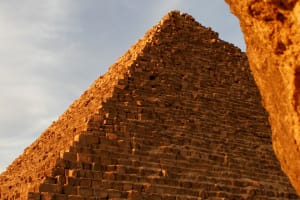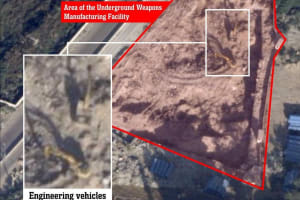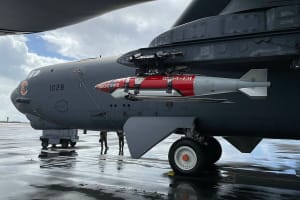What do we know about Israel’s ground offensive in Lebanon after two weeks of fighting?
Much remains unclear – like the ultimate aim of Israel's ground incursion

Almost two weeks ago, the IDF declared the start of “limited, localized and targeted ground raids” against Hezbollah terrorists and infrastructure in southern Lebanon.
Since then, the Israeli military, unlike the fighting against Hamas terrorists in Gaza, has kept a tight lid on information, such as detailed accounts of the battles and the exact locations of its forces.
In this explainer, we have compiled much of the available information, previously released and approved by the IDF’s military censor, to provide a comprehensive view of Israel’s ground offensive in southern Lebanon.
How many Israeli forces are in Lebanon?
While the IDF began the incursion with only one division, it gradually added more forces every couple of days. By now, four divisions are fighting in Lebanon: The 98th Commando Division, which spearheaded the operation, the 36th, the 91st, and the 146th, which joined the fighting last Tuesday.
It is unclear why Hezbollah is not conducting meaningful defensive operations in response to Israel’s ground operations. CTP-ISW noted on October 10 that Hezbollah fighters do not appear to be defending against Israeli forces in these villages, as the Israeli forces have… https://t.co/0NLVHD5gbv pic.twitter.com/lhTluvJyoL
— Institute for the Study of War (@TheStudyofWar) October 12, 2024
Every division entered southern Lebanon with at least three brigades, bringing the estimated number of soldiers to around 15-20,000, for now. To compare, the highest number of soldiers actively fighting in Gaza was reached around last November, when five divisions totaling some 25,000-50,000 troops were fighting Hamas.
An Israeli source told Sky News Arabia that the IDF was flooding the area with large forces to nip any possible Hezbollah resistance in the bud.
While the IDF hasn’t said where its troops are fighting, it has declared four closed military zones along stretches of the border, indicating that each of the four active divisions is conducting operations in the opposite area within Lebanon.
The zones are located between Rosh Hanikra and Arab al-Aramsheh: between Dovev and Malkia; between Malkia, Yiftah and Manara; and between Misgav Am, Metula, and Kfar Giladi.
A fifth zone was declared between Zar'it and Netoa on Saturday evening, indicating the imminent entry of additional forces.
The IDF has indicated a few areas where it is conducting operations within Lebanon, for example when it announced that soldiers of the 36th Division were fighting in the town of Bint Jbeil, which lies opposite the military zone around Dovev and Malkia.
What are the goals of the operation?
According to Channel 12 News military analyst Nir Dvori, the ground operation is only a part of Israel’s four-pronged strategy, which aims to create necessary conditions to allow the return residents of northern Israel to their homes.
The ground operation is aided by the aerial destruction of Hezbollah's infrastructure and capabilities deeper within Lebanon, including its launchers, storehouses, and production sites.
This is complemented by a campaign of continuous targeted assassinations of the group’s leadership, from its leader Hassan Nasrallah, down to lower-level field commanders, as well as choking Hezbollah off from weapons supplies by bombing border crossings and eliminating weapons smugglers.
The Jerusalem Post recently cited IDF sources who stated “that they expect to be in Lebanon longer than the two to three weeks originally set,” adding that “they were still just at the very beginning of taking apart Hezbollah's capabilities in southern Lebanon and that significant time could be needed.”
כוחות צה"ל ממשיכים לפעול בדרום לבנון כנגד תשתיות טרור ומחבלי חיזבאללה>> pic.twitter.com/D5rrRIWTfr
— צבא ההגנה לישראל (@idfonline) October 10, 2024
The Israeli source also told Sky News Arabia that the IDF hasn’t set specific geographical boundaries for the operation, and would pursue its goals, namely the elimination of Hezbollah’s leadership and its fighters, independent of them.
On the tactical level, all reports suggest that Israeli forces have focused mainly on capturing villages and towns that provided Hezbollah terrorists with launch positions overlooking Israeli towns in northern Galilee, as well as the forward positions of its elite Radwan Force.
The majority of the information released by the IDF has provided evidence of the enormous amount of weapons, ammunition and equipment stockpiled in dugouts and tunnels, some just meters to several kilometers from the Israeli border, to facilitate a planned large-scale invasion of Israel.
Determining the progress of the Israeli troops so far is difficult. Lebanese reports and information by the IDF both indicate that the army, contrary to its traditional battle doctrine, has not attempted to advance quickly and deeply into enemy territory.
Instead, its focus has been to systematically comb through the villages within a few kilometers of the border, eliminating terrorists while locating Hezbollah infrastructure and weapons stockpiles, and destroying them.
Why we are operating in southern Lebanon: pic.twitter.com/kGsqytshV6
— LTC Nadav Shoshani (@LTC_Shoshani) October 9, 2024
What do we know about the fighting on the ground?
Available information, both from the army, as well as from soldiers' accounts, suggests that while Hezbollah is a stronger enemy than Hamas, Israeli soldiers have routed them in every encounter.
A company commander in an engineering battalion told Walla News: “We expected much more resistance while entering, but when you get to the area, it is much less. What did one of the fighters tell me? ‘It reminds me 90% of the fighting in Gaza.’ The enemy’s fighting method is different… We have a lot of combat experience, and what remains is to make adjustments.”
Recently, I’ve been asked how we know that Hezbollah has been planning a wide scale invasion into Israel for years, here is your answer:
— LTC Nadav Shoshani (@LTC_Shoshani) October 5, 2024
This Hezbollah tunnel our troops found today, running 250 meters long and holding hundreds of weapons, has been built for years. This tunnel… pic.twitter.com/Tpsjj0vsgr
Similar to accounts from Gaza, soldiers say that in some villages, every single house has been turned into a combat position, including a stockpile of weapons, ammo and equipment, allowing Hezbollah fighters to act as if they are unarmed civilians but quickly gear up and start fighting when reaching their position.
According to Army Radio, the 98th Division alone has so far eliminated more than 200 terrorists, suggesting that the overall number could soon exceed 1,000. The troops have explained that while Hezbollah operates in a more orderly and organized manner than Hamas, one significant difference is that they are mainly above ground and not in tunnels.
“Hezbollah’s machine is working more smoothly, it's a different enemy – but we still have a clear superiority, working with a strong framework, with combined forces, power and cunning,” an officer told Army Radio.
Soldiers from the 36th Division, along with several other accounts, noted that direct confrontations with Hezbollah terrorists have been limited, as they prefer to lob anti-tank missiles, mortars, and rockets from a distance, avoiding face-to-face battles
“Part of the stunning story of the southern Lebanon invasion to date is that the IDF has only suffered one major ambush,” wrote Jerusalem Post military correspondent, Yonah Jeremy Bob.
“IDF sources attributed what so far has been a much better result, as compared to 2006, to a mix of the air force and artillery hitting Hezbollah in southern Lebanon for a year, along with the intense ramping up of strikes throughout Lebanon starting in mid-September last month. These strikes not only killed the Hezbollah high command strategists across Lebanon but also, more specifically, most of the lower-level tactical commanders in southern Lebanon.”
“We have not encountered the area prepared for defense with all of its capabilities and terrorists. Some of the terrorists fled, some were injured in the last year, some retreated to a more rear line and operate from a distance, and a few also remained,” soldiers told Army Radio.
“There is no enemy in sight, the villages are almost completely deserted,” a reservist wrote on 𝕏 several days ago. Regarding the IDF’s performance, he wrote: “There is a sense of an orderly plan, clear steps and amazing cooperation of ground artillery and air.”
“Even after 180 days in the reserve, there are high rates of reservists showing up and a strong spirit. To walk around freely in places where until a few months ago we ran around to avoid anti-tank missiles, is a tremendous feeling of satisfaction,” he added.
Nir Dvori also reported that Israeli soldiers identified signs of lagging morale among Hezbollah forces who fled from the front deeper into Lebanon. Meanwhile, they are not receiving reinforcements from the north.
Despite this, the IDF has sustained some losses and numerous injuries, primarily from anti-tank missiles. Soldiers have discovered thousands of these weapons, including advanced models produced in Russia and Iran. In some cases, areas have been defended to the last man, such as the municipality building in the town of Bint Jbeil.
To sum up, numerous soldiers and pundits have by now highlighted the stark difference between the IDF’s much-criticized performance in the last invasion, during the Second Lebanon War in 2006, and today.
After almost two weeks, the Israeli invasion of southern Lebanon is off to a great start. However, the scarce information released by the military makes it hard to gain a comprehensive picture of the fighting and understand the ultimate goals of the ground offensive.
What remains completely unclear is how deep the IDF intends to push into southern Lebanon, how many troops will be deployed, and which 'waypoints' the political echelon wants to see achieved before beginning negotiations for a ceasefire – if it even intends to do so at all.
This is, of course, part of the Israeli battle plan, and in itself suggests that the Israeli ground offensive is running according to plan.

Hanan Lischinsky has a Master’s degree in Middle East & Israel studies from Heidelberg University in Germany, where he spent part of his childhood and youth. He finished High School in Jerusalem and served in the IDF’s Intelligence Corps. Hanan and his wife live near Jerusalem, and he joined ALL ISRAEL NEWS in August 2023.














